Publications
Most recent publications
Most recent publications
Kindler-Mathôt, C. (2024). eins zwei drei vor wusch. Dynamische Entfaltung multimodaler Bedeutung einer onomatopoetischen Interjektion. In: S. Kabatnik, L. Bülow, M.-L. Merten, & R. Mroczynski (Eds.), Pragmatik multimodal (Vol. 7).
Müller, C.. (2024). A toolbox for methods of gesture analysis. In: Alan Cienki (ed.), The Cambridge Handbook of Gesture Studies, 182-216. Cambridge University Press.
Müller, C. (2024). Dead and Alive, Sleeping and Waking Metaphors: The Spectrum of Metaphor and the Multimodality of Discourse. In: Anders Örtenblad (ed.), The Oxford Handbook of Metaphor in Organization Studies. Oxford: Univ. Press.
Müller, C. (2024). Gestural mimesis as ‚as-if‘ action. In: Przemysław Zywiczynski, Johan Blomberg and Monika Boruta-Zywiczynska (eds.), Perspectives on Pantomime. Amsterdam/Philadelphia: John Benjamins.
Müller, C., Karpiński, M., Kindler-Mahôt, C., Klessa, K., Jarmołowicz-Nowikow, E., Junge, J., Papadopoulou, K., & Sawicka-Stępińska, B. (2024). Affectivity as stance. Multimodal stance-taking in audiovisual documentations of Polish and German parliamentary debates. Frontiers in Psychology, 15. https://doi.org/10.3389/fpsyg.2024.1467185
Müller C. (2023). Language from the Body – Dynamic relations between gestures and signed language. In: Terry Janzen and Barbara Shaffer (eds.), Signed Language and Gesture Research in Cognitive Linguistics, XIII-XVI. De Gruyter Mouton.
Müller, C. (2022). Obituary, Adam Kendon 1934-2022. In: Gesture 21, 2/3, 157-166.
Müller, C. (2019). Metaphorizing as Embodied Interactivity: What Gesturing and Film Viewing Can Tell Us About an Ecological View on Metaphor. Metaphor and Symbol 34 (1): 61–79.
Bressem J., S. H. Ladewig and C. Müller (2018). Ways of expressing action in multimodal narrations - The semiotic complexity of character viewpoint depictions. In: Anika Hübl and Markus Steinbach (eds.) Linguistic Foundations of Narration in Spoken and Sign Languages, 223–250. Amsterdam: Benjamins.
Cienki, Alan, O. K. Iriskhanova, R. B. Becker, D. Boutet, C. Debras, V. Denisova, M. Gonzalez-Marquez, A. Morgenstern, C. Müller and N. Richter (eds.) (2018). Aspectuality across Languages. Event Construal in Speech and Gesture, Amsterdam: Benjamins.
Greifenstein, S., D. Horst, T. Scherer, C. Schmitt, H. Kappelhoff, and C. Müller (2018). Cinematic metaphor in perspective. Reflections on a transdisciplinary framework. Berlin: De Gruyter.
Müller, C. (2018). Gesture and Sign: Cataclysmic Break or Dynamic Relations? Frontiers in Psychology 9:1651.
Müller, C. and H. Kappelhoff (2018). Cinematic Metaphor: Experience – Affectivity – Temporality. Berlin: De Gruyter.
Publications
Books
-
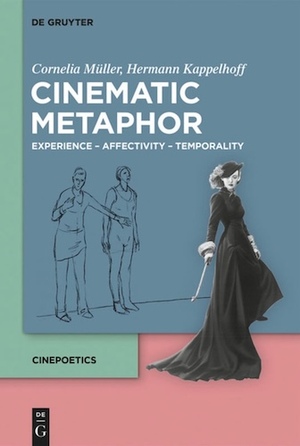
De Gruyter
Müller, Cornelia and Hermann Kappelhoff (2018). Cinematic Metaphor. Experience – Affectivity – Temporality in collaboration with Sarah Greifenstein, Dorothea Horst, Thomas Scherer and Christina Schmitt. Cinepoetics – English Edition 4, Berlin/Boston: De Gruyter Mouton.
Metaphors in audiovisual media receive increasing attention from film and communication studies as well as from linguistics and multimodal metaphor research. The specific media character of film, and thus of cinematic metaphor, remains, however, largely ignored. Audiovisual images are all too frequently understood as iconic representations and material carriers of information. Cinematic Metaphor proposes an alternative: starting from film images as affective experience of movement-images, it replaces the cognitive idea of viewers as information-processing machines, and heals the break with rhetoric established by conceptual metaphor theory. Subscribing to a phenomenological concept of embodiment, a shared vantage point for metaphorical meaning-making in film-viewing and face-to-face interaction is developed. The book offers a critique of cognitive film and metaphor theories and a theory of cinematic metaphor as performative action of meaning-making, grounded in the dynamics of viewers' embodied experiences with a film. Fine-grained case studies ranging from Hollywood to German feature film and TV news, from tango lesson to electoral campaign commercial, illustrate the framework’s application to media and multimodality analysis.
-
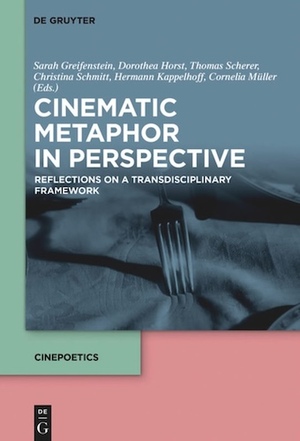
De Gruyter
Greifenstein, Sarah, Dorothea Horst, Thomas Scherer, Christina Schmitt, Hermann Kappelhoff and Cornelia Müller (2018). Cinematic metaphor in perspective. Reflections on a transdisciplinary framework. Berlin: De Gruyter.
Over centuries, scholars have explored how metaphor contributes to thought, language, culture. This collection of essays reflects on Müller, Kappelhoff, and colleagues’ transdisciplinary (film studies and linguistics) approach formulated in "Cinematic Metaphor: Experience – Affectivity – Temporality". The key concept of cinematic metaphor opens up reflections on metaphor as a form of embodied meaning-making in human life across disciplines.
The book documents collaborative work, reflecting intense, sometimes controversial, discussions across disciplinary boundaries. In this edited volume, renowned authors explore how exposure to the framework of Cinematic Metaphor inspires their views of metaphor in film and of metaphor theory and analysis more generally.
Contributions include explorations from the point of view of applied linguistics (Lynne Cameron), cognitive linguistics (Alan Cienki), media studies (Kathrin Fahlenbrach), media history (Michael Wedel), philosophy (Anne Eusterschulte), and psychology (Raymond W. Gibbs, Jr.).
-
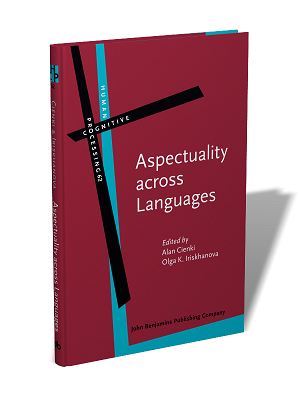
John Benjamins Publishing Company
Cienki, Alan, Olga K. Iriskhanova, Raymond B. Becker, Dominique Boutet, Camille Debras, Valeriya Denisova, Monica Gonzalez-Marquez, Aliyah Morgenstern, Cornelia Müller and Nicole Richter (eds.) (2018). Aspectuality across Languages. Event Construal in Speech and Gesture, Amsterdam: John Benjamins.
The book provides a nuanced, multimodal perspective on how people express events via certain grammatical forms of verbs in speech and certain qualities of movement in manual gestures. The volume is the outcome of an international project that involved three teams: one each from France, Germany, and Russia, including scholars from the Netherlands and the United States.
Aspect and gesture use are studied in three Indo-European languages, i.e. French, German, and Russian. The book also summarizes the main points and arguments from French, German, and Russian works on aspect in relation to tense, bringing these historical traditions together for an English-speaking reading audience.
The work rekindles some fundamental theorizing about events and aspect, reinvigorating it in a new light with the use of recent theorizing from cognitive linguistics and cognitive psychology, as well as new research methods applied to new data from actual spoken, interactive language use. It illustrates the value of researching the variably multimodal nature of communication – as well as theoretical issues in connection with thinking for speaking and mental simulation – from an empirical point of view.
-
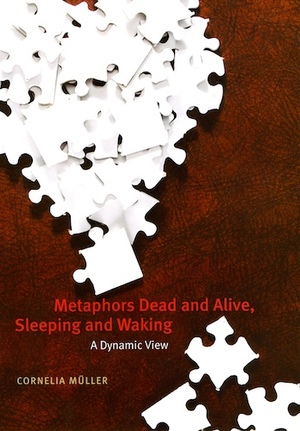
The University of Chicago Press
Müller, Cornelia (2008). Metaphors. Dead and alive, sleeping and waking. A dynamic view. Chicago: University of Chicago Press.
Traditional thinking on metaphors has divided them into two camps: dead and alive. Conventional expressions from everyday language are classified as dead, while much rarer novel or poetic metaphors are alive. In the 1980s, new theories on the cognitive processes involved with the use of metaphor challenged these assumptions, but with little empirical support. Drawing on the latest research in linguistics, semiotics, philosophy, and psychology, Cornelia Müller here unveils a new approach that refutes the rigid dead/alive dichotomy, offering in its place a more dynamic model: sleeping and waking.
To build this model, Müller presents an overview of notions of metaphor from the classical period to the present; studies in detail how metaphors function in speech, text, gesture, and images; and examines the way mixed metaphors sometimes make sense and sometimes do not. This analysis leads her to conclude that metaphors may oscillate between various degrees of sleeping and waking as their status changes depending on context and intention. Bridging the gap between conceptual metaphor theory and more traditional linguistic theories, this book is a major advance for the field and will be vital to novices and initiates alike. -
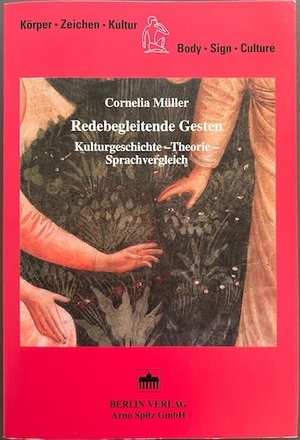
BERLIN VERLAG Arno Spitz
Müller, Cornelia (1998). Redebegleitende Gesten. Kulturgeschichte – Theorie – Sprachvergleich. Arno Spitz: Berlin.
Gesten sind kommunikative Bewegungen der Hände und Arme, die - ähnlich der Sprache - dazu verwendet werden, die Gedanken, Gefühle und Intentionen eines Sprechers zum Ausdruck zu brlngen und die soziale Ordnung des Gesprächs aktiv herzustellen. Redebegleitende Gesten sind eng mit der Syntax, Semantik, Pragmatik sowie der Diskursstruktur sprachlicher Äußerungen verbunden. Das Buch konzentriert sich auf drei Leitfragen: 1. Welches sind die historischen Beweggründe für eine negative Bewertung der Verwendung darstellender Gesten beim Sprechen und die damit einhergehende Vernachlässigung der gelehrten Betrachtung des Zusammenspiels von sprachlicher und gestischer Darstellung? 2. Welche Gestentypen gibt es, und wie sind die Eigenarten gestischer Darstellung zu charakterisieren? 3. Läßt sich das verbreitete Stereotyp des mit „Händen und Füßen" redenden Südeuropäers auf objektivierbare Eigenschaften der redebegleitenden Gestik von spanischen und deutschen Sprechern zurückführen?
Edited volumes
-
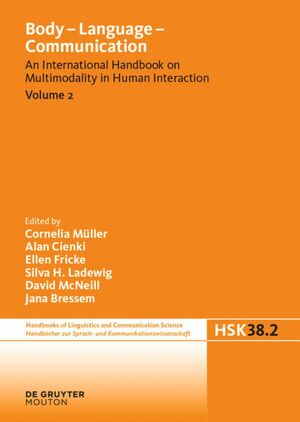
De Gruyter
Müller, Cornelia, Alan Cienki, Ellen Fricke, Silva H. Ladewig, David McNeill and Jana Bressem (eds.) (2014). Body – Language – Communication: An International Handbook on Multimodality in Human Interaction. (Handbooks of Linguistics and Communication Science 38.2.), Berlin/München/Boston: De Gruyter Mouton.
Volume II of the handbook offers a unique collection of exemplary case studies. In five chapters and 99 articles it presents the state of the art on how body movements are used for communication around the world. Topics include the functions of body movements, their contexts of occurrence, their forms and meanings, their integration with speech, and how bodily motion can function as language. By including an interdisciplinary chapter on ‘embodiment’, volume II explores the body and its role in the grounding of language and communication from one of the most widely discussed current theoretical perspectives. Volume II of the handbook thus entails the following chapters:
VI. Gestures across cultures,
VII. Body movements: functions, contexts and interactions,
VIII. Gesture and language,
IX. Embodiment: the body and its role for cognition, emotion, and communication,
X. Sign Language: Visible body movements as language -
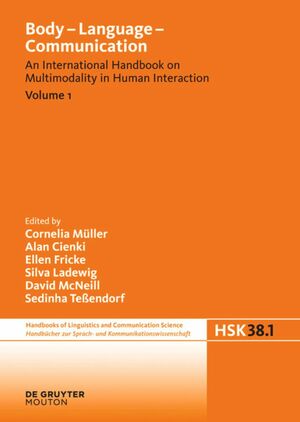
De Gruyter
Müller, Cornelia, Alan Cienki, Ellen Fricke, Silva Ladewig, David McNeill and Sedinha Teßendorf (eds.) (2013). Editor in chief: Body – Language – Communication: An International Handbook on Multimodality in Human Interaction. (Handbooks of Linguistics and Communication Science 38.1.), Berlin/Boston: De Gruyter Mouton.
Volume I of the handbook presents contemporary, multidisciplinary, historical, theoretical, and methodological aspects of how body movements relate to language. It documents how leading scholars from differenct disciplinary backgrounds conceptualize and analyze this complex relationship. Five chapters and a total of 72 articles, present current and past approaches, including multidisciplinary methods of analysis. The chapters cover:
I. How the body relates to language and communication: Outlining the subject matter,
II. Perspectives from different disciplines,
III. Historical dimensions,
IV. Contemporary approaches,
V. Methods. -

John Benjamins Publishing Company
Koch, Sabine C., Thomas Fuchs, Michela Summa and Cornelia Müller (eds.) (2012). Body Memory, Metaphor and Movement. Amsterdam: Benjamins.
Body Memory, Metaphor and Movement is an interdisciplinary volume with contributions from philosophers, cognitive scientists, and movement therapists. Part one provides the phenomenologically grounded definition of body memory with its different typologies. Part two follows the aim to integrate phenomenology, conceptual metaphor theory, and embodiment approaches from the cognitive sciences for the development of appropriate empirical methods to address body memory. Part three inquires into the forms and effects of therapeutic work with body memory, based on the integration of theory, empirical findings, and clinical applications. It focuses on trauma treatment and the healing power of movement. The book also contributes to metaphor theory, application and research, and therefore addresses metaphor researchers and linguists interested in the embodied grounds of metaphor. Thus, it is of particular interest for researchers from the cognitive sciences, social sciences, and humanities as well as clinical practitioners.
-
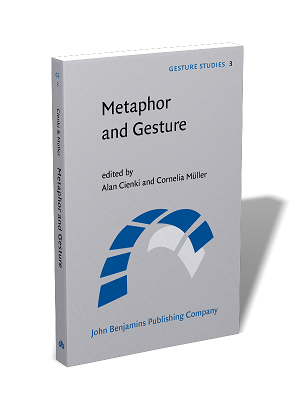
John Benjamins Publishing Company
Cienki, Alan and Cornelia Müller (eds.) (2008). Metaphor and Gesture. Amsterdam: Benjamins.
This volume is the first to offer an overview on metaphor and gesture — a new multi-disciplinary area of research. Scholars of metaphor have been paying increasing attention to spontaneous gestures with speech; meanwhile, researchers in gesture studies have been focussing on the abstract ideas which receive physical representation through metaphors when speakers gesture. This book presents a snapshot of the state of the art in these converging fields, offering research papers as well as commentaries from multiple perspectives. In addition to conceptual metaphor theory it includes different theoretical approaches to semiotics, and the methods used range from controlled experimentation, to cognitive ethnography, to lexical semantic analysis. The use of metaphor in gesture is shown to reflect idiosyncracies of thought in the moment of speaking as well as structural, cultural, and interactional patterns. The series of commentaries discusses the potential importance of studying metaphor and gesture from the perspectives of such fields as anthropology, cognitive linguistics, conversation analysis, psychology, and semiotics.
-
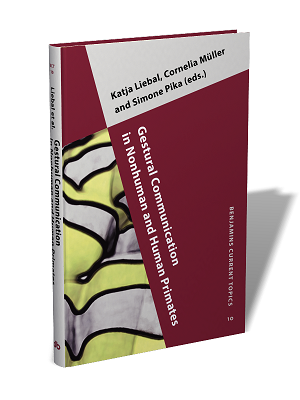
John Benjamins Publishing Company
Liebal, Katja, Cornelia Müller and Simone Pika (eds.) (2007). Gestural communication in nonhuman and human primates. Amsterdam: Benjamins.
Research into gestures represents a multifaceted field comprising a wide range of disciplines and research topics, varying methods and approaches, and even different species such as humans, apes and monkeys. The aim of this volume (originally published as a Special Issue of Gesture 5:1/2 (2005)) is to bring together the research in gestural communication in both nonhuman and human primates and to explore the potential of a comparative approach and its contribution to the question of an evolutionary scenario in which gestures play a significant role. The topics covered include the spontaneous natural gesture use in social groups of apes and monkeys, but also during interactions with humans, gestures of preverbal children and their interaction with language, speech-accompanying gestures in humans as well as the use of sign-language in human and nonhuman great apes. It addresses researchers with a background in Psychology, Primatology, Linguistics, and Anthropology, but it might also function as an introduction and a documentation state of the art for a wider less specialised audience which is fascinated by the role gestures might have played in the evolution of human language.
-
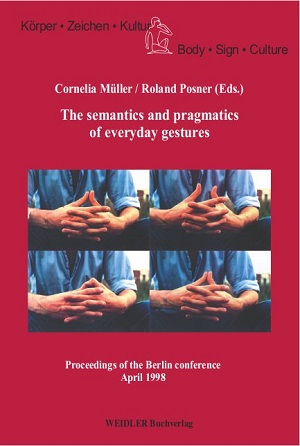
Weidler Verlag
Müller, Cornelia and Roland Posner (eds.) (2004). The semantics and pragmatics of everyday gestures. The Berlin conference. Berlin: Weidler Verlag.
This book offers a survey of two core aspects of human gesture hitherto not systematically addressed. It provides a range of different approaches to the study of semantic and pragmatic properties of everyday gestures and hence may be regarded as one step further towards a necessary documentation of gestures as a semiotic system substituting and interacting with language and speech.
The book is divided into two parts. While the first part assembles articles which focus on the semantics and pragmatics of conventionalized gestures (also called emblems or autonomous , lexical, quotable and symbolic gestures) and problems of a lexicography of those gestures, the second part of the book brings together articles which document many different aspects of the ways in which gestures are used in interaction.
The first part is centered around the lexicography of gestures and provides ’solutions’ as well as general ’problem areas’ to the production of dictionaries of everyday gestures and hence offers a valuable starting point for an international and interdisciplinary discourse in the field of gesture lexicography.
The second part exemplifies various approaches to the documentation of gestures in interaction while at the same time documenting aspects of gesture’s usages in different situation and across different cultures.
The book offers itself as an introduction to various fields of gesture studies as well as a survey over current fields of research.
